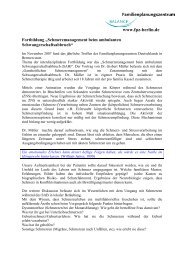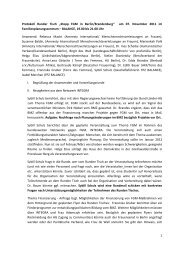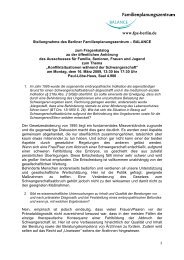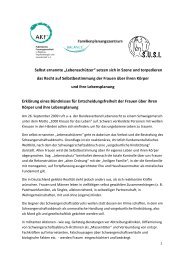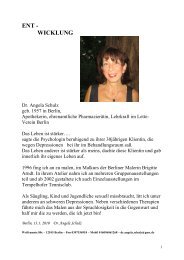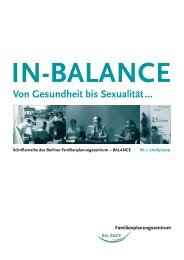Listening to African Voices - FPZ
Listening to African Voices - FPZ
Listening to African Voices - FPZ
Create successful ePaper yourself
Turn your PDF publications into a flip-book with our unique Google optimized e-Paper software.
Table 26: Knowledge of German law and attitudes <strong>to</strong>wards the abandonment of FGM/C (Nigeria)AllowsFGM/CLegislation% distribution of participants whobelieve that German lawDoes notallow itDoes notmention itAttitudes <strong>to</strong>wards abandonment% distribution of participantswho believe that FGM/C shouldDon’t know/Doesn’t answer Continue Be s<strong>to</strong>pped DependsDon’t know/Doesn’t answerSexWomen 1.3 74.0 1.3 23.4 1.3 81.8 11.7 5.2Men 0.7 71.4 2.9 25.0 12.2 64.7 18.7 4.3Age groups16-30 0 68.3 2.4 29.3 4.9 80.5 9.8 4.931-44 1.8 71.1 2.6 24.6 7.0 69.3 20.2 3.645+ 0 82.2 15.6 2.2 13.6 72.7 11.4 2.3ReligionMuslim 2.2 63.0 4.3 30.4 10.9 52.2 32.6 4.4Christian 0 74.8 1.9 23.3 7.6 76.6 11.4 4.4Education (years)0-9 0 56.3 37.5 6.3 15.6 50.0 25.0 9.410-14 0.9 73.3 3.4 22.5 5.2 74.8 15.7 2.615+ 1.6 79.0 1.6 17.7 9.7 75.8 12.9 1.6Total 0.9 72.4 2.3 24.4 8.3 70.8 16.2 4.6then I cannot see anything good in it and would never doit myself. But if it is their culture and if those who practiceit are convinced that it is good, they shall do what theywant <strong>to</strong> do.” (woman of Nigerian origin)5.5.4. Cameroon5.5.4.1. Socio-demographic profileThe (officially registered) Cameroonian immigrant communityin Hamburg lies at 500, with a higher proportion of men(n = 270) than women (n = 213). We reached a <strong>to</strong>tal of 110participants during the quantitative survey, 41 women and69 men. We met very few Cameroonians with an unclearresidence status. Most of them (66%) are in Hamburg <strong>to</strong>pursue their university education which explains the highaverage education level among Cameroonian immigrants.5.5.4.2. Proportion of immigrant population concernedFGM/C is rare in Cameroon. The national prevalence estimateis 1.4% (Institut National de Statistiques & ICF Macro2004). The practice is carried out by very few of Cameroon’snumerous ethnic groups and even within practicing groups,the extent is less then 13% (1.4% for the Bantus in theSouth West and 12.7% for the Fulani/Kanuri, Arabe/Choa/Maoussa in the far North). The DHS conducted in 2004 indicatedthat the practice is declining further. Geographically,the practice is concentrated in the Far North and in someareas of the South Western region.The interviewed participants were affiliated with 30 differentethnic groups. The majority is from non-practicing groups,namely the Bamileke which make up 40% of the interviewedsample. Almost 14% were affiliated with potentially practicinggroups, more precisely the Bantu (11%) and the Fulani (3%).When we asked the participants whether or not they werefrom a practicing group and family, gender differencesbecame apparent: about 12 women (31%) declared thatFGM/C was taking place in their group while only five men(7%) did so. Amazingly, half of these participants wereBamileke, a group that is not known for practicing FGM/C.It can be assumed that these participants simply assumedthat FGM/C takes place within their group as the Bamilekerepresent one of the largest ethnic groups and are, as traders,found in all areas of Cameroon.To the question whether FGM/C takes place in their family,the majority of the participants answered in the negative.Only three women and two men reported that it waspracticed in their family. They were from five different ethnicgroups: Hausa, Bantu, Fulani, Bamileke and Bamoun. Fiveother participants (two women and three men) respondedthat they didn’t know whether or not FGM/C was takingplace in their family as they never heard anyone talkingabout it.<strong>Listening</strong> <strong>to</strong> <strong>African</strong> <strong>Voices</strong> 53






